A perfect native pick for those who are looking at establishing a colourful garden, Hardenbergia violacea is a prostrate subshrub that features narrow lance-shaped dark-green leaves and masses of purple, pink or occasionally white flowers depending on which cultivar you grow.
It is now widely grown as an ornamental garden plant and it is a great choice for any gardener regardless of experience. Here is your full guide to growing and caring for this spectacular native flowering plant.
More...
Family: | Fabaceae |
|---|---|
Genus: | Hardenbergia |
Species: | H. violacea |
Common Names: | False sarsaparilla, purple coral pea, vine lilac |
Location: | Outdoor |
Type: | Flowering plant |
Growth: | 4 metres tall and wide |
Sun requirements: | Full sun to part shade |
Foliage Colour: | Green |
Flower Colour: | Purple, pink or white (varies depending on cultivar) |
Flowering: | Winter to Spring |
Maintenance level: | Low |
Poisonous for pets: | Non-toxic to cats and dogs |
Hardenbergia violacea Introduction
This heavy flowering, low-maintenance evergreen can boost the appeal of any garden no matter the setting. It offers a vibrantly colourful influence within landscapes with its masses of delicate, pea-shaped flowers amidst wiry foliage and lush leathery leaves.
It can be used in many decorative applications and there are many exciting cultivars to choose from. Its roots are non-invasive and this plant is particularly hardy when grown in the right conditions.
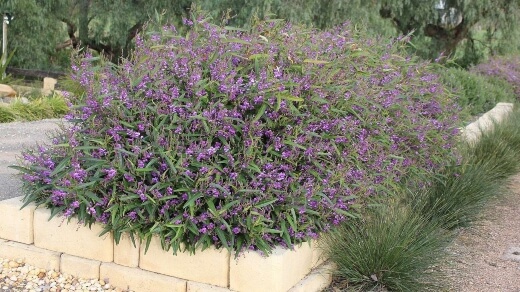
Source: alpinenurseries.com.au
Native to many open forests and woodlands throughout Australia, this plant is now commonly known as false sarsaparilla, purple coral pea or vine lilac.
There are 3 species of Hardenbergia where the violacea species and its cultivars are the most commonly grown as they are the most ornamental and easygoing of the lot.
All cultivars form a part of the Papilionaceae family of Australian natives and all varieties are considered fast-growing in cultivation.
Purple Coral Pea Growing Habits
These plants grow best in cool to mild tropical climates and are not suited for colder regions. Recent breeding has allowed for many climbing varieties as well as many upright shrubby cultivars, meaning you are sure to find one that suits your garden's aesthetic and landscaping needs.
This plant grows to about 4 metres tall and wide in gardens but its size and shape can be controlled quite easily. It is most commonly used as trailing cover for fences, ground cover, trellis growing, used as a feature specimen or mass planted for maximum flowering effect in landscapes.
Thanks to its shallow root system, it also makes for an excellent addition to patios in pots or planters.
Most Popular Hardenbergia violacea Varieties
Hardenbergia violacea ‘Happy Wanderer’

Source: ucanr.edu
Happy wanderer plant is probably the most commonly grown in Australia. It is a vigorous climbing and trailing variety that produces masses of lilac to purple flowers between winter and spring.
It is also a larger growing variety that can provide dense cover wherever needed in gardens.


Get Your Free Guide:
Master Growing Australian Natives eBook
A Must Have Complete Guide for Every Australian Garden
Get Your Free Guide:
Master Growing Australian Natives eBook
A Must Have Complete Guide for Every Australian Garden
Hardenbergia violacea ‘Alba’
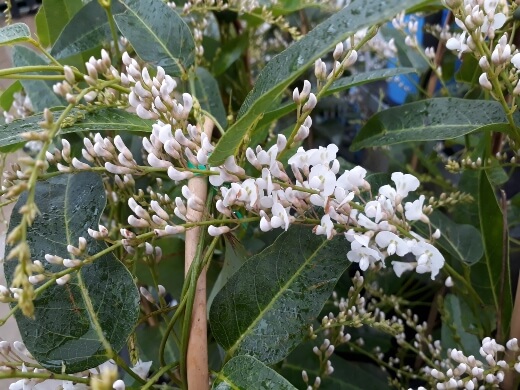
Source: brenlissaonlinenursery.com.au
This smaller growing variety produces white pea-shaped flowers in spring. The leaves are dark and glossy which helps to create a drastic contrast between the bright white flowers amidst the dark backdrop of the foliage. This cultivar grows to around 1.2 metres tall and wide.
Hardenbergia violacea ‘Free-n-Easy'
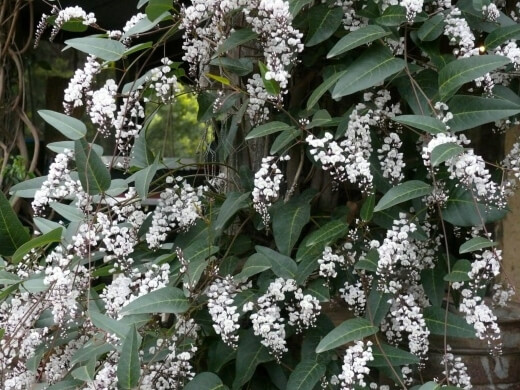
Source: thetutuguru.com.au
This variety is a vigorous climber, with dark green leaves and long, lacy white flowers with hints of lavender.
Hardenbergia violacea ‘Bushy Blue’
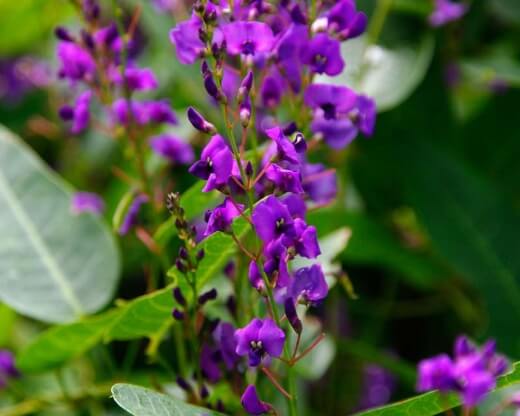
Source: gardensonline.com.au
This low-growing shrub variety only reaches about 60 centimetres tall and wide in cultivation. It features blueish-grey leaves and gorgeous clusters of vibrant violet to purple pea-shaped flowers.
Hardenbergia violacea ‘Mini Haha'
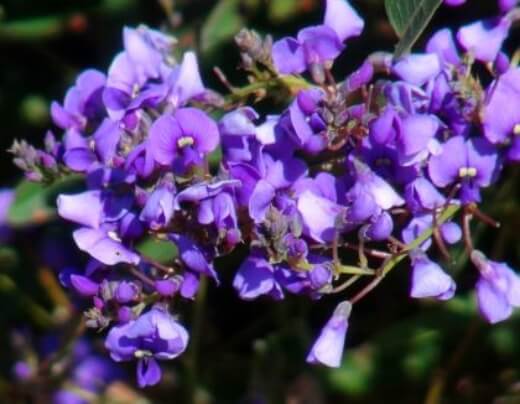
Source: gardensonline.com.au
This variety is compact and shrubby with purple flowers. It also has smaller leaves than the other cultivars.
Hardenbergia violacea ‘Purple Falls'
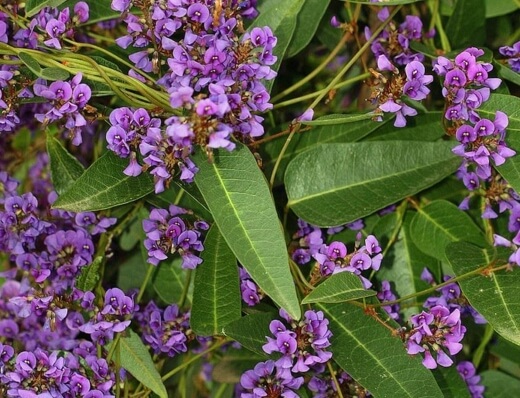
Source: plantmark.com.au
This variety is a vigorous trailing ground cover and does not climb. It produces purple pea-shaped flowers in spring.
Hardenbergia violacea ‘Rosea’
This vigorous small shrub can also be used as a climber. As its name suggests, it produces masses of soft-pink flowers in spring. This cultivar grows to about 1.5 metres tall and wide.
It looks fantastic in mass-planted situations where the pink array of flowers can easily spruce up your outdoor spaces with gentle hues of colour.
Hardenbergia violacea ‘Pink Fizz'
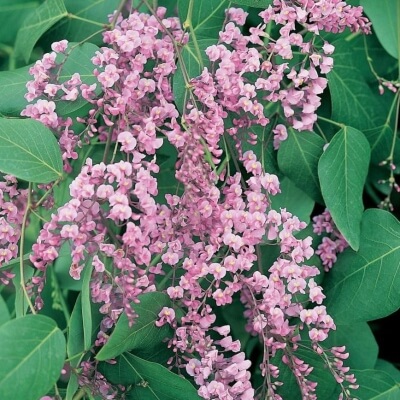
Source: flowerpower.com.au
This variety is a fast-growing climber with leathery dark green leaves and produces masses of pink flowers from winter to spring.
How to Grow Hardenbergia violacea
Young plants are readily available at many nurseries or garden centres that can easily be established in your garden. Alternatively, these plants can reliably be grown from seeds or propagated using softwood cuttings.
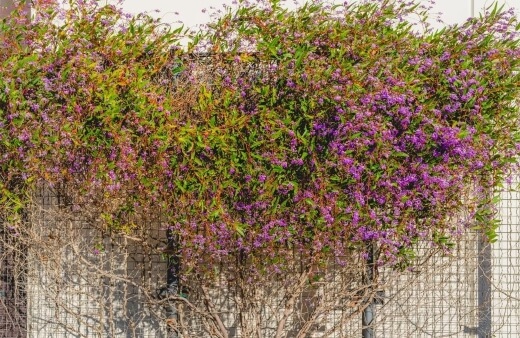
Hardenbergia violacea Propagation
Growing Vine Lilac from Seeds
- After flowering, seed pods will form on the plant. Collect your pods in late summer once they have dried. Extract the fertile seeds from the pods when you’re ready to start growing. It is best to sow seeds in spring.
- Soak your seeds overnight in hot water to help soften the seed shells. This will drastically help with germination.
- For bigger seeds, you may also need to slightly slash the seed shells with a sharp knife to further speed up germination.
- Prepare seedling containers filled with a premium seedling mix or potting mix.
- Sow your seeds about halfway into the soil as they will need some light to germinate best. Cover lightly with some soil.
- Water the seeds after sowing to reach a moderate moisture level in the soil.
- Place the seeds in a warm, sheltered location with indirect light.
- The seeds will germinate best in warm temperatures of at least 21°C.
- For help in creating a warmer, moister environment for your seeds, you can cover the containers with some plastic wrap.
- Keep the soil lightly moist at all times and you should see healthy signs of growth in about 2 to 4 months depending on the conditions.
- Allow the seedlings to develop for another few months before transplanting them.
Propagating False Sarsaparilla Using Softwood Cuttings
- During spring to early summer, take softwood cuttings from flexible young shoot tips. Your cuttings should be at least 15cm in length.
- Prepare your propagation containers filled with cutting compost or a high-quality potting mix.
- Dip the cut end of each cutting into some rooting hormone then plant each cutting about halfway deep into the soil.
- Water well after planting.
- Place your cuttings in a warm and sheltered position with temperatures of between 18 to 24°C for the best results.
- The cuttings will need healthy humidity levels to grow new roots so you can also cover them with some plastic if needed. Remove the plastic twice per week for at least 15 to 20 minutes at a time.
- The cuttings must receive some partial light each day and the soil should be kept moist for the first 6 to 10 weeks of growth.
- Once you have seen your cuttings have rooted well after about 3 months or so, you can pot them individually or plant them straight into the garden.
Ideal Planting Conditions for Purple Coral Pea
The best time of the year to plant is in late winter when warmer temperatures are inbound. Be sure to consider that these plants are known to spread and climb so most growers tend to plant them in strong raised beds to control their position better, especially when used as feature plants.
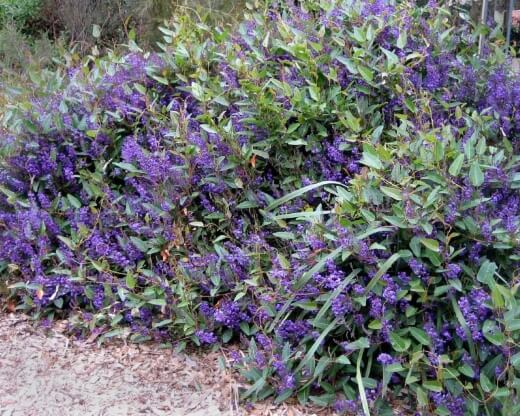
Source: gardensonline.com.au
Lighting Needs for Purple Coral Pea
This plant performs and flowers best in full sun to partially shaded positions. In temperate regions, it would be best to plant in full sun but if you experience very hot summers, planting in a location that gets some afternoon shade will be appreciated by your plant.
Best Soil for Optimal Growth
These hardy natives can tolerate a wide range of soil types as long as the growing medium is well-draining. Your plant will grow best in enriched, fast-draining soil with a slightly acidic pH of between 5.5 and 6.0.
Growing in a raised bed is also highly recommended for these trailing plants as the soil can be optimised easier and growth can be controlled.
For potted plants, use a loam-based potting mix for the best results. To test your soil, you can use this soil kit that contains 20 tests.
Hardenbergia violacea Care Tips
As mentioned, this plant is only lightly tolerant to frost, hence why it may struggle in colder climate zones. As it grows, your plant will become hardier with age but ideally, you want to allow your plant to grow in temperatures above 6°C at all times.
It is also best to never transplant established specimens so be sure to choose your growing location carefully.
Pruning Purple Coral Pea
These natives respond very well to pruning, allowing growers to closely control the size and shape of their plants. After flowering, cut back up to two-thirds of the plant to encourage new vigorous growth and a bushier appearance.
Be sure to always remove any dead or damaged foliage as needed to ensure your plant gets proper air circulation at all times. If you love growing native plants then you will find this guide on pruning native plants quite useful.
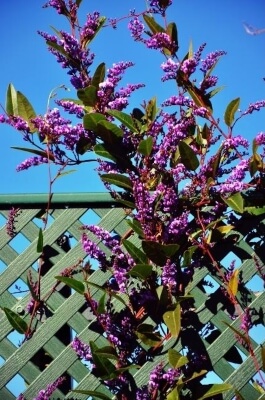
Ideal Watering Routine
As your plant establishes itself in the initial growing season, it will need more water, especially after planting. Established plants won’t need much supplementary water unless in cases of long hot and dry spells.
Always water the plant at the base and avoid watering the foliage to decrease the risk of fungal infections. The soil should be slightly moist in warmer months and in winter, you can drastically cut back on watering.
Don’t let the soil dry out for long periods as these plants are not very tolerant to drought.
Fertilising Vine Lilac
You can feed your plant with a general-purpose slow-release fertiliser in spring and autumn for prolific blooms. Supplementary feeding with a complete liquid fertiliser or native fertiliser every 3 to 4 weeks can assist with overall health and vigour.
Avoid fertilising in winter. Always water the fertiliser in well after application.
Mulching Needs
After planting, add organic mulch to a depth of about 5cm to improve soil moisture and suppress weeds around the base of the plant.
Hardenbergia violacea Pests & Diseases
Generally, these hardy natives are pretty resistant to pests and disease problems when grown in the right conditions. Plants grown in cool moist environments can be susceptible to powdery mildew and some plants can also experience infestations of scale insects and mealybugs, especially when mass planted.
Powdery Mildew
Identifiable by white, powdery spots or patches that form on the top sides of leaves and plant stems, this fungal disease can spread quickly if left untreated.
Severe infection can lead to yellowing and twisting leaves which will leave your plant looking drab and miserable. To treat powdery mildew, you can use neem oil which will rapidly disperse the fungal spores.
Alternatively, you can use an appropriate organic fungicide for mildew available at reputable garden centres or online vendors.
Scale Insects/Mealybugs/Caterpillars
Monitor foliage to detect any signs of leaf damage as your plant grows. Caterpillars can become a nuisance but you can easily get rid of them by manually removing them from your plant and disposing of them off-property.
Smaller pests like scale insects or mealybugs can also be a problem, especially in mass planting situations. Using gloves, scrape off any of these small pests from the undersides of leaves or stems.
Alternatively, use a soap and water mixture to spray and knock them off the foliage. For severe infestations, spray your plant occasionally with neem oil and prune back infected stems.
Hardenbergia violacea FAQs
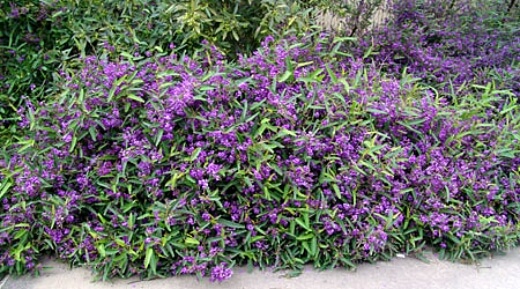
Source: andreasensgreen.com.au
Does Hardenbergia attract bees?
The flowers are known to attract bees, especially when grown among other flowering plants.
Does Hardenbergia need a trellis?
If you intend on growing yours as a climbing plant, be sure to provide a supporting structure such as a trellis or cages.
How tall does Hardenbergia grow?
Depending on the variety and growing conditions, these plants usually grow with a spread of 2 to 5 metres and a height of up to 6 metres.
Does Happy Wanderer Hardenbergia have invasive roots?
The root systems are shallow and therefore non-invasive. The roots are not strong enough to become invasive in any way so feel free to establish these plants near structures or in rockeries.
If you’re an avid grower of native plants and flowers, be sure to check out our informative guide below to get all the necessary tips and tricks when establishing native gardens:
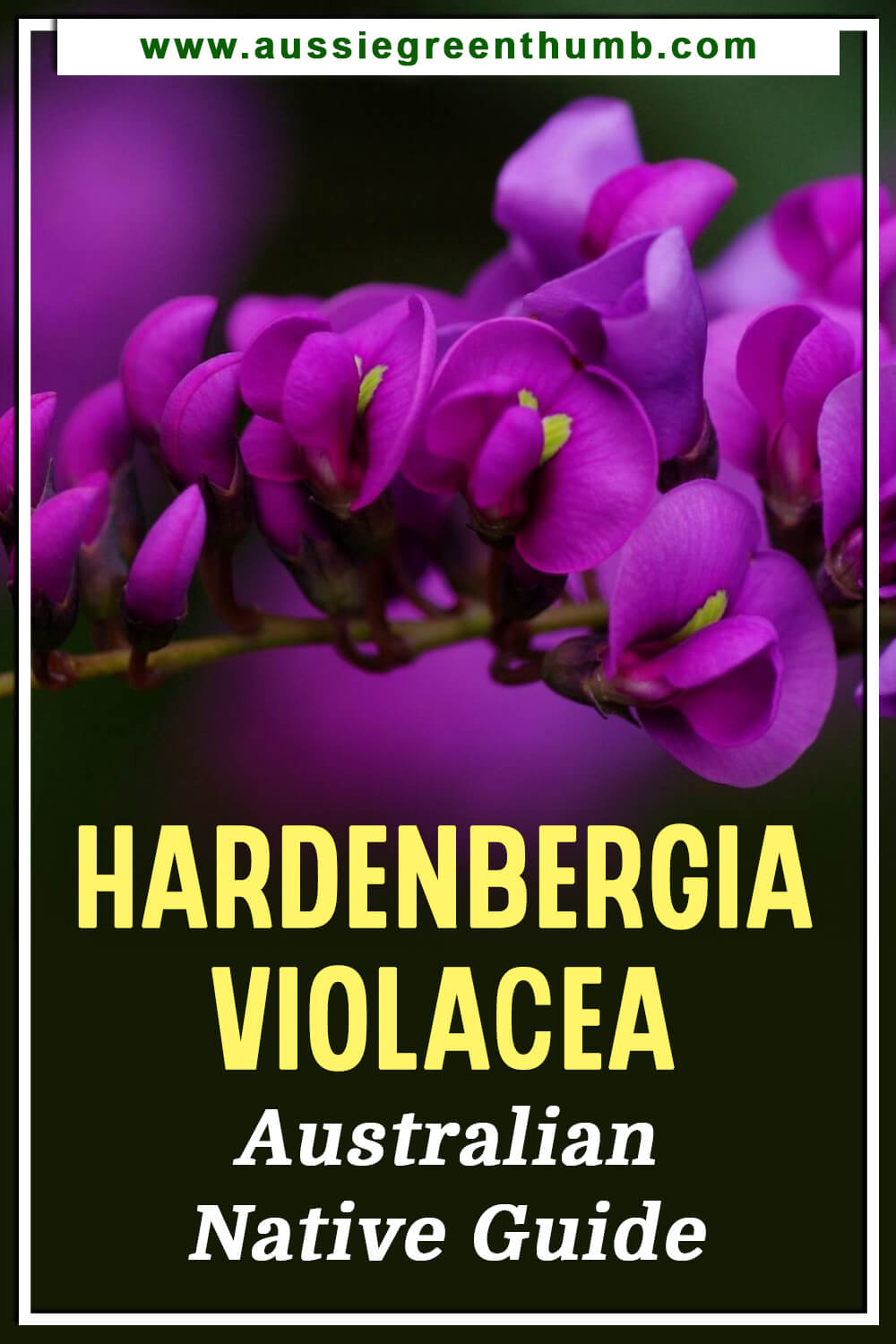
Form Flamboyant & Decorative Outdoor Spaces with Hardenbergia violacea
This spectacular native flowering plant can add incomparable colour and liveliness to any garden. Whether planted alone, in groups or among other flowering natives, purple coral pea will stand out and offer lush and brilliant tones and textures to your landscape.
Being one of the most ornamental in its genus and with so many beautiful cultivars to choose from, Hardenbergia violacea is an easy pick for anyone looking at adding more colour to their gardens without the hassle of high maintenance.
Published on July 29, 2022 by Nathan Schwartz
Last Updated on January 26, 2025




